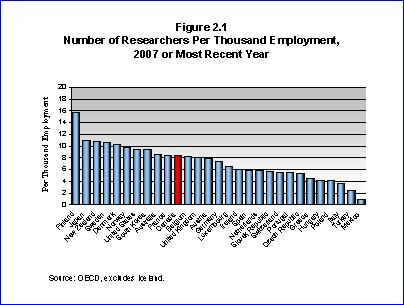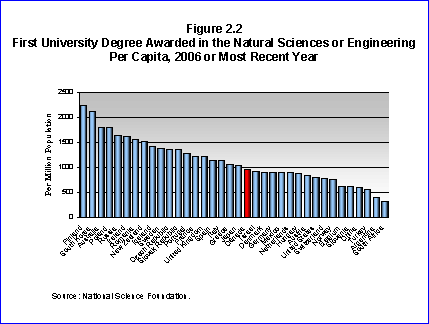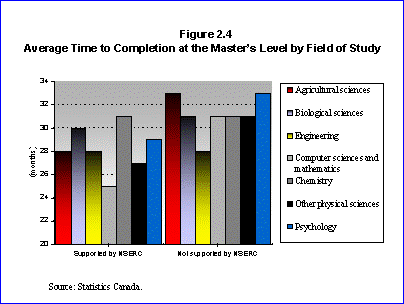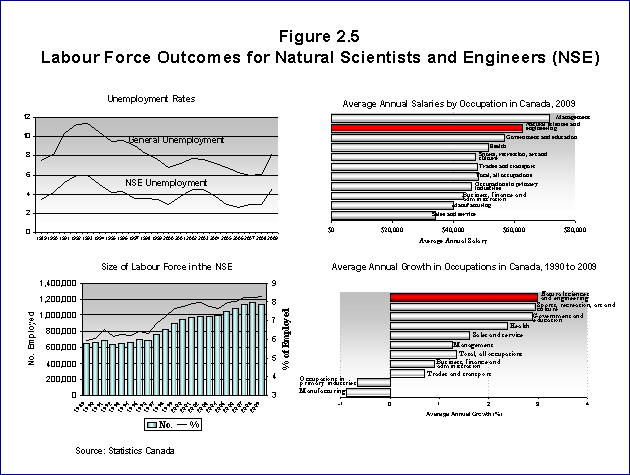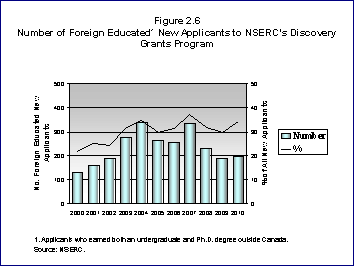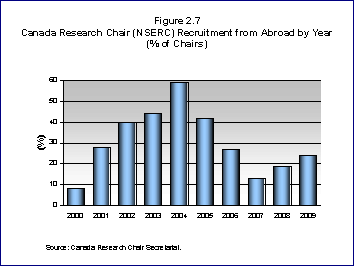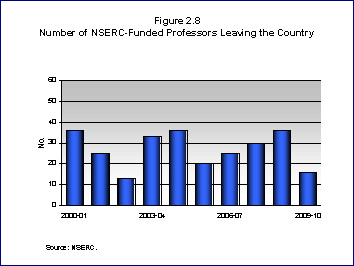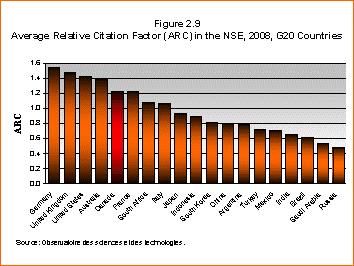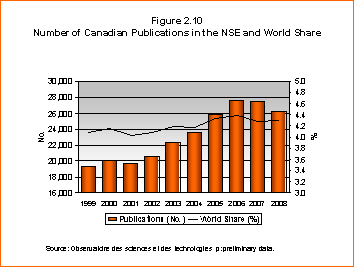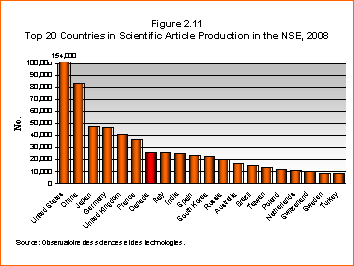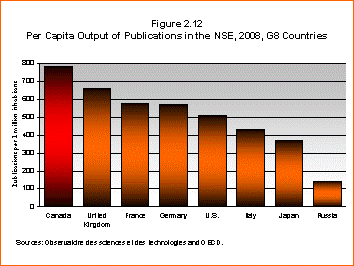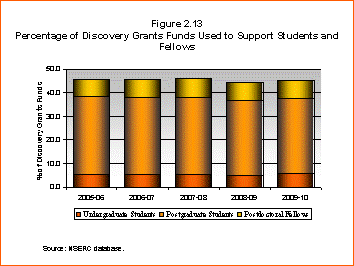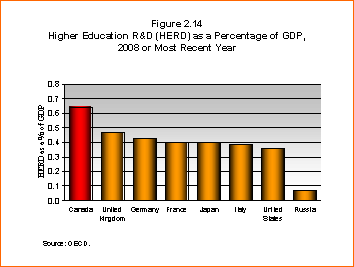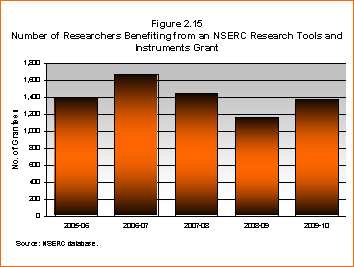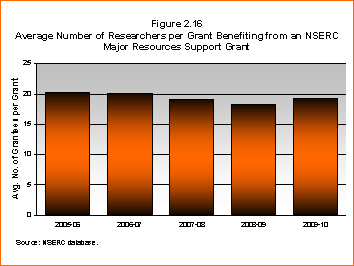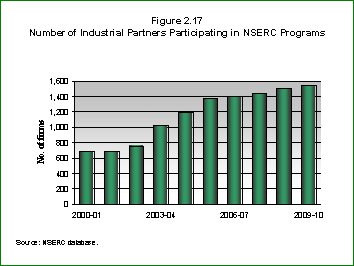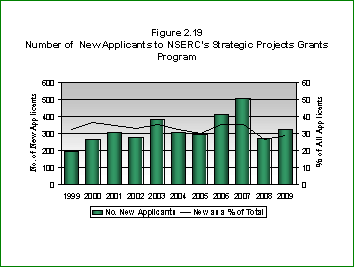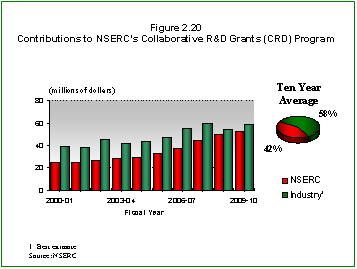Common menu bar links
Breadcrumb Trail
ARCHIVED - Natural Sciences and Engineering Research Council of Canada - Report
 This page has been archived.
This page has been archived.
Archived Content
Information identified as archived on the Web is for reference, research or recordkeeping purposes. It has not been altered or updated after the date of archiving. Web pages that are archived on the Web are not subject to the Government of Canada Web Standards. As per the Communications Policy of the Government of Canada, you can request alternate formats on the "Contact Us" page.
Section II – Analysis of Program Activities by Strategic Outcome
Strategic Outcome - Highly Skilled Science and Engineering Professionals in Canada
By supporting 29,500 students and fellows at Canadian universities and abroad, providing programs to support university faculty, and promoting science and engineering to Canadian youth, NSERC will ensure a reliable supply of highly qualified personnel (HQP) for Canadian industry, government, and academia. The majority of NSERC-funded students have a strong interest in a career in R&D and the performance data collected indicates that this is occurring to a large degree. The training support NSERC provides will help Canada maintain or improve the number of researchers employed in the country. Figure 2.1 presents the total researchers per thousand employed relative to other Organization for Economic Cooperation and Development (OECD) countries. Canada currently stands in 11th position, but only slightly (less than 2%) behind Australia in 9th. Canada’s ratio of number of researchers per thousand employed has grown by 26% over the past decade as compared to the OECD average growth rate of 19%.
Number of Researchers Per Thousand Employment, 2007 or Most Recent Year
The following provides details of NSERC’s performance for the three program activities that fall under this strategic outcome. Resulting benefits to Canada include: building a stronger culture of science and innovation in our country and encouraging young people to study science and engineering, increasing the number of people with advanced degrees in science and engineering, and supporting top scientists and engineers to serve as magnets to other high-calibre researchers and students to come to, or to remain in, Canada.
Program Activity: Promote Science and Engineering
| 2009-10 Financial Resources ($ millions) |
2009-10 Human Resources (FTEs) |
||||
|---|---|---|---|---|---|
| Planned Spending |
Total Authorities |
Actual Spending |
Planned | Actual | Difference |
| 6.5 | 6.6 | 6.6 | 1 | 1 | 0 |
| Expected Results |
Performance Indicators |
Targets | Performance Status |
Performance Summary |
|---|---|---|---|---|
| Student interest in research in the sciences, math and engineering is encouraged. | Percentage of science promotion projects that successfully complete the planned activity | Greater than 80% | Exceeded | Post award surveys indicate that 85% of PromoScience grants successfully fulfill the objectives of the grant. |
| Number of knowledge transfer activities that target teachers | Greater than 100 | Exceeded | More than 200 knowledge transfer activities benefiting more than 2,500 teachers were conducted. |
| Program | Description | Expenditures 2009-10 $ millions) |
|---|---|---|
| PromoScience | PromoScience provides support to non-profit and public organizations that work with young Canadians in order to build their interest in science and engineering, motivate and encourage their participation in science and engineering activities, and train teachers who are responsible for the science and math education of young Canadians. | 2.7 |
| CRYSTAL | CRYSTAL (Centres for Research in Youth, Science Teaching and Learning) provides a forum for the many partners who share an interest in developing and enhancing the skills of, and resources available to, science and mathematics teachers, and in enriching the preparation of Canadian children in these foundation subjects. | 0.6 |
| Prizes | NSERC prizes recognize outstanding individual Canadian researchers, research teams and students. They enhance the career development of outstanding and highly promising scientists and engineers and distinguish the sustained excellence of faculty members at Canadian universities. They also publicly recognize lasting partnerships in R&D between university and industry and celebrate young Canadian entrepreneurs. | 2.4 |
The PromoScience program is allowing organizations active in science promotion to expand their offerings and to engage many more young Canadians, especially girls and aboriginal youth. This is critical as young Canadians are less inclined to select science or engineering as a discipline when they enter university (see Figure 2.2) as compared to many other nations. At the end of each PromoScience grant a final report is submitted. For those grants ending in 2009-10, 85% of recipients rated the outcome of the grant as successful. These grants enabled the recipient organizations to reach hundreds of thousands of Canadian youth and promote a science culture.
PromoScience Recipient – ACTUA
Science and Engineering Camps for Aboriginal Youth in Six Rural, Northern and Underserved Communities
This PromoScience grant supported the delivery of customized hands-on science and engineering workshops as well as summer camps for Aboriginal youth in the following six identified communities: Rankin Inlet; Igloolik, Tuktoyaktuk, Kugaruuk, Nain, and Charlottetown. Over the course of the three year grant the total number of youth reached was 3,125. These results were more than four times the original projection of 750 youth.
The objective of the program was to engage and inspire Aboriginal youth to explore and discover science and engineering using fun activities related to their daily lives. In addition, Aboriginal community members served as role models and mentors to assist with the delivery of culturally relevant programming. The NSERC grant allowed for the development of new and relevant programming and a new week of curriculum was developed with fresh activities covering subjects such as space, ecology, engineering and chemistry. The activities in this program were designed to include elements of problem solving and team building and all activities demonstrate to youth how science and engineering are relevant to their daily lives. Most importantly, through their involvement in this program, aboriginal youth learned that they have a significant role to play in shaping a diverse new generation of discoverers and innovators.
The CRYSTAL Pilot Program was created in October 2003. The program has increased the scale and changed the nature of research activities in science, mathematics and technology education. The program has increased knowledge translation and outreach activities, with the Centres having undertaken a wide variety of activities focused on reaching teachers. By the end of the third year, Centres had conducted an estimated 677 knowledge translation activities targeting teachers and developed approximately 479 knowledge translation tools for teachers. Although the program had successful results it did not progress past the pilot phase after the Strategic Review of 2008-09 because it was not considered to be central to NSERC’s mandate.
To recognize the important achievements of Canadian research scientists and engineers, and, in the process, to help retain faculty in Canada, NSERC awards significant research prizes to individuals and teams. A profile of the 2009-10 winner of NSERC’s Gerhard Herzberg Canada Gold Medal for Science and Engineering is presented below.
Gilles Brassard, Computer Science
Universit� de Montr�al
Ranking among the most influential computer scientists in the world, Gilles Brassard is recognized as the founder of quantum information science in Canada and one of its earliest pioneers worldwide. Through his visionary thinking and groundbreaking research, he has played a pivotal role in transforming this field from what initially appeared to be a fringe pursuit into an exciting and dynamic research area in which quantum mechanics is exploited in novel methods to enhance our information-processing capabilities in ways previously thought to be impossible.
Professor Brassard’s most celebrated breakthroughs are the invention of quantum cryptography and quantum teleportation, both universally recognized as fundamental cornerstones of the entire discipline. His other influential discoveries include privacy amplification, entanglement distillation and amplitude amplification. Quantum cryptography makes it possible to communicate in perfect secrecy under the nose of an eavesdropper who has unlimited computational power and whose technology is restricted only by the laws of physics.
The author of three books, translated into eight languages, and former Editor-in-Chief of the Journal of Cryptology, Professor Brassard’s papers and books have been cited more than 15,000 times. Among his many honours, he is the first Canadian to have been elevated to the rank of Fellow by the International Association for Cryptologic Research.
Program Activity: Support Students and Fellows
| 2009-10 Financial Resources ($ millions) |
2009-10 Human Resources (FTEs) |
||||
|---|---|---|---|---|---|
| Planned Spending |
Total Authorities |
Actual Spending |
Planned | Actual | Difference |
| 152.2 | 168.8 | 159.9 | 24 | 26 | +2 |
| Expected Results |
Performance Indicators |
Targets | Performance Status |
Performance Summary |
|---|---|---|---|---|
| A supply of highly qualified people with leading-edge scientific and research skills for Canadian industry, government, and universities. | Percentage of students supported that are actively employed in Canada after graduation | 75% | Exceeded | 82% of students supported were working in Canada 9 years after their award. More than one-half of those abroad were planning to come back to Canada (NSERC survey data, see Figure 2.3) |
| Average completion rates among NSERC award recipients vs. general NSE student population | Completion rate 10% greater than general NSE student population | Exceeded | 98% of the respondents completed the degree (master’s or doctoral) for which they received NSERC funding (NSERC survey data, see Figure 2.3) vs. overall degree completion of 80%. |
| Program | Description | Expenditures 2009-10 ($ millions) |
|---|---|---|
| Undergraduate Student Research Awards | Held in university (3,411) or industry laboratories (740), this program provides funding for an undergraduate student to spend a four-month work term in a university or industrial research environment. | 18.6 |
| NSERC Postgraduate Scholarships | At the master’s (920) and doctoral (1,564) levels, NSERC supports students by providing an annual stipend that enables them to continue to pursue their research interests. Up to four years of support is available over the course of a candidate’s graduate studies. Opportunities for study at institutions in Canada and abroad as well as at Canadian industrial laboratories (544) are available. | 51.7 |
|
Canada Graduate Scholarships (CGS) |
Canada Graduate Scholarships (tenable only at Canadian universities) are awarded to the most outstanding candidates at the master’s (1,156) and doctoral (1,037) levels. CGS Foreign Study Supplements (82) allow CGS scholars to pursue short-term training outside the country. In the first year of the program, 54 awards were made under the new Vanier CGS. | 59.1 |
|
NSERC Postdoctoral and Industrial R&D Fellowships |
These two-year awards support researchers who have completed their Ph.D., and provides them with funds to continue their programs of research. The awards may be held at any academic institution through a Postdoctoral Fellowship (504), or at a Canadian company that conducts research through an Industrial R&D Fellowship (214). | 20.9 |
NSERC provides direct financial support to students from the undergraduate to postdoctoral levels through key programs as described above. In addition, NSERC funds students and fellows through support provided by an NSERC-funded professor from his or her NSERC grant. The training of 18,200 students and fellows is supported in full or in part through this route.
NSERC conducts ongoing surveys of funded students at all levels. Figure 2.3 highlights some important achievements of NSERC-funded students and fellows. All of NSERC’s scholarship and fellowship programs are achieving their objectives and the funded students are going on to well-paying and productive jobs in Canada. Almost all (98%) of the NSERC-funded students complete their degree and they do so in a shorter period than unfunded students (see Figure 2.4).
Since 1978, NSERC has supported the training of nearly 90,000 master’s and doctoral students in the NSE. General macro-level economic outcomes for university graduates in the natural sciences and engineering provide ample evidence of the positive outcomes for NSERC-funded students, both directly and indirectly supported. As Figure 2.5 demonstrates, unemployment levels for persons seeking work in natural science or engineering occupations are considerably below national levels; annual salaries for this group are nearly one-third greater than the national average; and employment opportunities continue to grow as the natural science and engineering labour force surpasses the 1,000,000 mark resulting in the fastest growing occupational group over the past 20 years.
In 2009-10 an evaluation of NSERC’s Postgraduate Scholarships program and the Canada Graduate Scholarships program was concluded, with major findings highlighted below.
|
NSERC Postgraduate Scholarships(PGS)/Canada Graduate Scholarships (CGS)
|
Figure 2.3 - Results Related to NSERC Scholarships and Fellowships
| Short-term Outcomes7 |
|---|
|
| Longer-term Outcomes8 |
|
| Short-term Outcomes |
|---|
|
| Longer-term Outcomes |
|
| Short-term Outcomes |
|---|
|
| Longer-term Outcomes |
|
Average Time To Completion at the Master's Level by Field of Study
Labour Force OUtcomes for Natural Scientists and Engineers (NSE)
Canada’s Economic Action Plan
Through Canada's Economic Action Plan (CEAP), the federal government temporarily expanded the Canada Graduate Scholarships program which supports Canada’s top graduate students. This included $35 million over three years to the Canada Graduate Scholarships Program (CGS) in order for the Natural Sciences and Engineering Research Council of Canada to provide an additional 200 doctoral scholarships for three years beginning in 2009-10 and 400 master’s scholarships in both 2009-10 and 2010-11.
Through CEAP, the federal government also provided an additional $3.5 million over two years to offer an additional 600 graduate internships in science and business, through the Industrial Research and Development Internship (IRDI) program launched in Budget 2007. The IRDI Program creates additional opportunities for skilled graduate students and postdoctoral fellows, by linking them with businesses that foster and utilize their talents. As a result, the program increases the science and technology (S&T) orientation of businesses and creates new opportunities for highly qualified personnel.
Accelerate Canada was awarded $2.5 million of the CEAP stimulus funding for the IRDI program as supplement to their current grant to provide an additional 350 internships in 2009-10, for a total of 1000 internships. In addition, following a strong performance review, their award is being extended by one year using the remaining $1 million from Budget 2009 and the original $5.8 million from Budget 2007, to deliver 1000 internships in 2010-11.
Although it is too early tohave collected performance information for the CEAP spending, it is highly likely that the results will be very similar to the excellent results highlighted for postgraduate students and postdoctoral fellows in Figure 2.3.
Program Activity: Attract and Retain Faculty
| 2009-10 Financial Resources ($ millions) |
2009-10 Human Resources (FTEs) |
||||
|---|---|---|---|---|---|
| Planned Spending |
Total Authorities |
Actual Spending |
Planned | Actual | Difference |
| 167.2 | 165.2 | 154.6 | 11 | 11 | 0 |
| Expected Results |
Performance Indicators |
Targets | Performance Status |
Performance Summary |
|---|---|---|---|---|
| Enhanced research capacity in science and engineering | Number of foreign-educated new applicants to NSERC’s Discovery Grants program | Greater than 100 per year | Exceeded | Canada continues to attract faculty from abroad in large numbers (see Figures 2.6 and 2.7). Nearly 200 new Discovery grantees came from abroad in 2010. |
| Number of NSERC-funded professors leaving the country | Less than 100 per year | Exceeded | Less than 0.5% of NSERC grantees leave Canada to work abroad in a given year (see Figure 2.8). Only 16 left the country in 2009-10. |
| Program | Description | Expenditures 2009-10 ($ millions) |
|---|---|---|
| Canada Research Chairs | This tri-agency (NSERC, CIHR and SSHRC) program provides financial support for up to 2,000 professors across Canada, including 900 positions within the NSE. The key objective of this program is to enable Canadian universities to achieve the highest levels of research excellence and to become world-class research centres in the global knowledge-based economy. | 117.6 |
| NSERC Industrial Research Chairs | NSERC’s Industrial Research Chairs program helps universities build the critical mass of expertise and long-term relationships with corporate partners in areas of research that are of importance to industry. Industrial Research Chairs can also enhance the ability of universities to recruit senior-level researchers and research leaders from industry or other sectors. | 27.0 |
Figure 2.6 presents the number of new applicants to NSERC’s largest program, the Discovery Grants program, who received both their bachelor’s and Ph.D. degrees outside the country (this number is a good proxy for an overall evaluation of the “attraction” activity since the vast majority of new professors in the natural sciences and engineering apply to the program). As the figure indicates, Canadian universities continue to attract hundreds of foreign educated personnel every year to become professors. More than 30% of the large number of first-time NSERC applicants are foreign educated. Recent investment by the government in university research has created an attractive environment to conduct research and highly trained people from other countries are coming to Canada to pursue their career.
The Canada Research Chairs program has helped to create a research environment that is conducive to the long-term retention and attraction of top researchers. A significant number of Chair holders have been attracted from outside Canada and many top Canadian scientists have stayed in the country as a result of Chair support. Figure 2.7 presents the percentage of external recruits awarded a Canada Research Chair in the natural sciences and engineering since the program’s inception. (Note: fluctuations in Figure 2.7 are due to small cohorts in some years.)
Number of Foreign Educated New Applicants to NSERC's Discovery Grants Program
Canada Research Chair (NSERC) Recruitment from Abroad by Year (% of Chairs)
NSERC also tracks the reasons grantees provide when they terminate their awards before the end date. As shown in Figure 2.8, only a small number of professors receiving NSERC support listed “leaving the country” as the reason for terminating their award over the past decade. The number of NSERC-funded professors leaving the country is an extremely small percentage of the nearly 12,000 professors receiving NSERC support each year and is much smaller than the number of new professors attracted to Canada each year (see Figures 2.6 and 2.7).
Number of NSERC-Funded Professors Leaving the Country
One of the 21 new Industrial Research Chairs in 2009-10 was awarded to Eldad Haber of the University of British Columbia for his work related to geosciences. A profile of Dr. Haber’s Chair is presented below:
Eldad Haber
NSERC/ Barrick/Xstrata/Teck/Newmont/Vale Industrial Research Chair in Computational Geoscience
Electromagnetic methods have been used by the industry for the discovery of minerals, oil, underground contamination and, recently, to monitor CO2. A key component in using the technology is the ability to simulate electromagnetic fields in highly homogeneous media and, given electromagnetic measurements, produce a 3D image of the earth that it is consistent with the data. The work proposed by the chair is the development of modern simulation and optimization algorithms and codes to produce a flexible and accurate representation of electromagnetic fields in the earth and the corresponding conductivity. The codes and algorithms developed in this research can improve the accuracy of mineral detection making exploration more profitable and with a smaller environmental footprint.
The chairholder has worked for Schlumberger and for the last seven years has been at Emory University’s mathematics and computer science department as a computational science faculty member. For the last 15 years, the chairholder was involved in generating modeling and simulation codes for mining companies worldwide.
Mining and mining exploration represent a large part of the Canadian economy. Improving mining exploration by making it more economical and environmentally friendly is an important economic target. Furthermore, the generation of codes will take the industry to the next technological phase and will require highly qualified personnel who will bring more “high-tech” jobs to the mining industry.
Strategic Outcome - High Quality Canadian-Based Competitive Research in the NSE
NSERC promotes and enables global excellence in discovery research. Basic research provides the foundation for all scientific and technological advances, and also to train the people who can generate new knowledge in Canada and understand new knowledge generated around the world. Having a solid capacity for basic research across a broad range of traditional fields in natural sciences and engineering, to newly established fields like genomics, nanotechnology and quantum computing, ensures that Canada remains at the leading-edge of knowledge creation. It also ensures that Canada can access and exploit S&T developments from other countries.
One of the first tangible outcomes of an investment in university R&D is a publication in a scientific or engineering journal. Since the vast majority (nearly 90%) of Canada’s scientific and engineering publications are produced by university researchers, publications are a good indicator of the immediate outcome from NSERC research funding and can be used to benchmark our performance against the rest of the world.
Similar to common rating systems, in which a higher score indicates more viewers, listeners or readers, citations are a measure of the potential use of a researcher’s work by fellow researchers. If a researcher’s work is being referenced or cited more often by his/her peers, then there may be more intrinsic value to the work. Based on the number of citations received by papers over the three years following the publication year, a standardized measure called the Average Relative Citation Factor (ARC) is then calculated for each country and field and normalized to 1.0 to indicate the world average. Figure 2.9 presents the ARC values for the G20 in the NSE in 2008. Canada’s ARC in the NSE ranks 5th and is only slightly behind the top four countries.
Average Relative Citation Factor (ARC) in the NSE, 2008, G20 Countries
The following provides details of NSERC’s performance for the two program activities that fall under this strategic outcome. Resulting benefits to Canada include: global excellence in discovery research, new knowledge, the ability to access and exploit knowledge developed outside Canada, and attracting the best minds to Canada and keeping them here by furnishing state-of-the-art equipment and facilities to carry out research at world-class levels.
Program Activity: Fund Basic Research
| 2009-10 Financial Resources ($ millions) |
2009-10 Human Resources (FTEs) |
||||
|---|---|---|---|---|---|
| Planned Spending |
Total Authorities |
Actual Spending |
Planned | Actual | Difference |
| 366.9 | 365.1 | 362.9 | 52 | 53 | +1 |
| Expected Results |
Performance Indicators |
Targets | Performance Status |
Performance Summary |
|---|---|---|---|---|
| The discovery, innovation and training capability of university researchers in natural sciences and engineering is enhanced by the provision of support for on-going programs of basic research | World ranking in number of publications | Maintain top 10 world ranking (Canada is currently 7th) | Met All | Canada has maintained its 7th place ranking in publication production (see Figure 2.11). |
| Percentage of funds spent on training of students and postdoctoral fellows | 35% | Exceeded | In 2009-10, 45.2% of Discovery Grants funds were used to support students and fellows (see Figure 2.13). | |
| Higher education expenditure on R&D (HERD) as a percentage of gross domestic product (GDP) compared to G8 countries | Maintain current world ranking (Canada is currently 2nd) | Met All | Canada currently ranks 1st in HERD as a % of GDP in the G8 (see Figure 2.14). |
| Program | Description | Expenditures 2009-10 ($ millions) |
|---|---|---|
| Discovery Grants | The Discovery Grants program is the mainstay of support for university-based research. The program provides funding for ongoing programs of research. Researchers are free to work in the mode most appropriate for the research area and they may pursue new research interests provided they are within NSERC’s mandate. To be funded, they must demonstrate both research excellence and high productivity, and contributions to the training of HQP. | 343.4 |
Canada is among an elite group of countries publishing a significant number of articles in science and engineering journals. Since the beginning of the century, Canadian researchers (all sectors) in the NSE have increased their annual production of publications from roughly 20,000 per year to current averages of approximately 25,000 publications per year, as shown in Figure 2.10. Overall, Canada’s world share of NSE papers stood at 4.3% in 2008, ranking seventh in the world (see Figure 2.11). Indicators of productivity as they relate to scientific publication production can also be useful. One indicator is a measure of a country’s output of NSE publications per capita population. Figure 2.12 presents the 2008 per capita output per one million inhabitants for the G8. Using this criterion, Canada has the highest per capita output.
Number of Canadian Publications in the NSE and World Share
Top 20 Countries in Scientific Article Production in the NSE, 2008
Per Capita Output of Publications in the NSE, 2008, G8 Countries
The training of highly qualified personnel (HQP) is of critical importance in the Discovery Grants program. Each year, nearly 50% of program expenditures are used by professors to support students at the undergraduate, master’s and doctoral levels, and postdoctoral fellows (see Figure 2.13). In 2009-10, 10,700 students and fellows were supported by Discovery Grants funding.
Percentage of Discovery Grants Funds Used to Support Students and Fellows
In 2008, member countries of the Organization for Economic Co-operation and Development (OECD) spent $191 billion on university research. Canadian university professors and students performed 5.3% of this total, up from 4.8% in 1999. When measured as a percentage of GDP, Canada spends more on university research than all of its G8 competitors (see Figure 2.14) and ranks 5th in the world.
Higher Education R & D (HERD) as a Percentage of GDP, 2008 or Most Recent Year
Program Activity: Support for Research Equipment and Major Resources
| 2009-10 Financial Resources ($ millions) |
2009-10 Human Resources (FTEs) |
||||
|---|---|---|---|---|---|
| Planned Spending |
Total Authorities |
Actual Spending |
Planned | Actual | Difference |
| 46.4 | 40.3 | 74.2 | 9 | 9 | 0 |
| Expected Results |
Performance Indicators |
Targets | Performance Status |
Performance Summary |
|---|---|---|---|---|
| The discovery, innovation and training capability of university researchers in the NSE is supported by their access to research equipment and major regional or national research facilities | Average number of researchers benefiting from equipment awards | Over 1500 | Mostly met | In 2009-10, 1,376 researchers benefited from an NSERC RTI grant (see Figure 2.15). |
| Average number of researchers benefiting from a Major Research Support award | Greater than 10 | Exceeded | In 2009-10, 19 researchers, on average, per Major Research Support award were supported (see Figure 2.16). |
| Program | Description | Expenditures 2009-10 ($ millions) |
|---|---|---|
| Major Resources Support (MRS) | The MRS program supports researchers’ access to major regional or national research facilities by assisting these facilities to remain in a state of readiness for researchers to use. This program is the vehicle for NSERC investments in facilities such as the Canadian Light Source synchrotron in Saskatoon. | 36.8 |
| Research Tools and Instruments Grants (RTI) | CFI funding enhances the laboratory setting by funding major equipment and infrastructure purchases. RTI grants enable professors to purchase the smaller pieces of laboratory equipment necessary to conduct world-class research. This critical source of funding ensures researchers have access to the modern research tools required to ensure the maximum return on other investments in research, such as Discovery Grants. | 36.5 |
NSERC’s Research Tools and Instruments (RTI) funding generally leads to more, faster and more in-depth research as well as better trained HQP. These impacts are felt across the spectrum of disciplines, in all regions and in large and small institutions. It is difficult for researchers to find funding for small equipment and NSERC is a major source. NSERC’s RTI grants are capped at $150,000 and with most of the awards less than $80,000, there is currently no or little overlap between NSERC’s RTI program and Canada Foundation for Innovation (CFI) grants. Figure 2.15 highlights the number of researchers benefiting from an NSERC RTI grant.
Number of Researchers Benefiting from an NSERC Research Tools and Instruments Grant
The Major Resources Support (MRS) program leads to a better use of the funded facilities, increased collaboration among researchers and improved international competitiveness of Canadian researchers. The program also complements CFI funding for several facilities (e.g., Canadian Light Source) by providing the necessary operating and maintenance support to fully utilize the facilities. Figure 2.16 presents the average number of researchers benefiting from an MRS award. The average value has been fairly steady over the past five years.
Average Number of Researchers per Grant Benefiting from an NSERC Major Resources Support Grant
Strategic Outcome - Productive Use of New Knowledge in the NSE
Wealth is created when Canadians add value in producing goods and services that are sold in world markets, and knowledge is the modern basis for adding value. NSERC aims to maximize the value of public investments in research for the benefit of all Canadians by promoting research-based innovation, academic-industry partnerships, knowledge and technology transfer activities and the training of people with the required scientific and business skill sets to create wealth from new discoveries in the NSE.
NSERC gives companies operating from a Canadian base access to the special knowledge, expertise and educational resources at Canadian postsecondary institutions and offers opportunities for mutually beneficial collaborations that result in industrial or economic benefits to Canada. The industrial partners contribute financially to university research projects, scholarships and fellowships. In 2009-10, more than 1,500 firms in Canada partnered with NSERC, up from the 700 partners in 2000-01 (see Figure 2.17). Over this ten-year period the average annual growth rate in the number of partners has been 9.3%. Sixty-two of the top 100 R&D firms in Canada are currently partners with NSERC (Note, many of the top 100 not partnering with NSERC are in the health/biotechnology sector).
Number of Industrial Partners Participating in NSERC Programs
The following provides details of NSERC’s performance for the three program activities that fall under this strategic outcome. Resulting benefits to Canada include: building capacity in areas critical to the Canadian economy, in carefully selected strategic priorities for the country and connecting researchers with end users in order to transfer and exploit knowledge and to increase Canadian prosperity.
Program Activity: Fund Research in Strategic Areas
| 2009-10 Financial Resources ($ millions) |
2009-10 Human Resources (FTEs) |
||||
|---|---|---|---|---|---|
| Planned Spending |
Total Authorities |
Actual Spending |
Planned | Actual | Difference |
| 124.1 | 124.2 | 104.0 | 21 | 21 | 0 |
| Expected Results |
Performance Indicators |
Targets | Performance Status |
Performance Summary |
|---|---|---|---|---|
| Research and training in targeted and emerging areas of national importance is accelerated | Percentage of researchers applying for a strategic grant (or who have never applied in a specific area) for the first time | Over 30% | Mostly met | In 2009-10, 28.8% of applicants in the Strategic Project competition were new (see Figure 2.19). |
| Program | Description | Expenditures 2009-10 ($ millions) |
|---|---|---|
| Strategic Project Grants | This program accelerates research and training in targeted and emerging areas of national importance. The research is early-stage with the potential to lead to breakthrough discoveries. The program target areas coincide extremely closely to the government’s current priority areas of the environment, energy, information and communications technologies, manufacturing, automotive applications, forestry, fisheries, and health. | 61.0 |
| Strategic Network Grants | This program funds large scale, complex research programs that involve multi-sectoral collaborations on a common research topic. The topic to be investigated can be of local concern, requiring a focused local network, or of regional or national importance, requiring a larger, more complex network. | 31.9 |
The Strategic Partnerships Programs are designed to focus on priorities (NSERC Strategic Target Areas) and thus provide an excellent framework to implement the S&T Strategy. An analysis of the 2009-10 Strategic Partnerships Program grants indicated that more than 90% of program funding was devoted to government priority areas.
In 2009-10, a total of $27.5M was leveraged from partners in Strategic Partnership grants in addition to NSERC’s funding of $92.9M. Given the pre-competitive nature of Strategic Partnership grants, the resulting leverage ratio of 30% indicates excellent partner participation. The number of industrial partners in these programs continues to grow and in 2009-10 stood at 550, for a 64% increase over the past five years (see Figure 2.18).
Number of Industrial Partners - Strategic Partnerships
Creating new partnerships between professors and industrial/government partners to facilitate the knowledge and technology transfer process in priority areas is an important component of the Strategic Projects program. Figure 2.19 presents the number of researchers who have applied for a Strategic Project grant for the first time. Overall, roughly 30% of applicants to the program are new each year.
Number of New Applicants to NSERC's Strategic Projects Grants Program
Program Activity: Fund University-Industry-Government Partnerships
| 2009-10 Financial Resources ($ millions) |
2009-10 Human Resources (FTEs) |
||||
|---|---|---|---|---|---|
| Planned Spending |
Total Authorities |
Actual Spending |
Planned | Actual | Difference |
| 109.3 | 110.5 | 119.9 | 42 | 46 | +4 |
| Expected Results |
Performance Indicators |
Targets | Performance Status |
Performance Summary |
|---|---|---|---|---|
| Mutually beneficial collaborations between the private sector and researchers in universities, resulting in industrial or economic benefits to Canada | Percentage growth in partner contributions | Greater than 5% | Met All | Average annual growth rate over the past ten years in industrial partner contributions on CRD grants has been 5% (see Figure 2.20). |
| Partner satisfaction with research results | 75% of partners indicating satisfaction | Exceeded | Post award surveys indicate that more than three-quarters of partners are extremely satisfied with their collaboration with university researchers and students. |
| Program | Description | Expenditures 2009-10 ($ millions) |
|---|---|---|
| Collaborative Research and Development (CRD) Grants | This program gives companies operating from a Canadian base access to the unique knowledge, expertise and educational resources available at Canadian postsecondary institutions and offers opportunities for mutually beneficial collaborations that result in industrial or economic benefits to Canada. | 52.5 |
| Networks of Centres of Excellence (NCEs) | The Networks of Centres of Excellence (including the Business-Led Networks) are unique partnerships among universities, industry, government and not-for-profit organizations aimed at turning Canadian research and entrepreneurial talent into economic and social benefits for all Canadians. These nationwide, multidisciplinary and multi-sectoral research partnerships connect excellent research with industrial know-how and strategic investment. They create a critical mass of research capacity by networking researchers and partners across Canada. | 47.6 |
Industrial contributions related to Collaborative Research and Development (CRD) Grants is an important indicator of the value NSERC’s partners place on university research. A comparison of the NSERC funding and industry contributions to the CRD program is presented in Figure 2.20. NSERC’s industrial partners contribute more to the CRD projects than NSERC and over the past 10 years the average annual growth rate in contributions has been an impressive 5%, increasing from $39 million in 2000-01 to $59 million in 2009-10.
Contributions to NSERC's Collaborative R & D Grants (CRD) Program
NSERC tracks the outcomes of its Collaborative Research and Development (CRD) program by following-up with researchers and partners. Results from the latest follow-ups are described below:
- Reports on CRD grants submitted by grantees required an overall ranking to assess the extent to which the overall objectives of the program were achieved. The answers were rated on a scale of 1 to 7 where 1 meant “not at all”, the midpoint indicated “somewhat” and 7 indicated “to a great extent.” 74% of reports responded with a rating of 6 or 7 indicating that objectives and milestones were achieved to a large extent. There were no responses that indicated that objectives were “not met at all”.
- Out of 276 reports, 49% of the projects reported contribution to new products or processes and 67% of projects reported contribution to improved products or processes.
- There were 18 new licenses generated and 103 patents had been filed. Twenty-four of those had been reviewed at the time reports were received. Start-up companies were created for 13 projects.
An evaluation of the CRD program was conducted in 2009-10 which covered the 1997-2008 period. A summary of the major findings is presented below.
|
Collaborative Research and Development (CRD) Program
|
In 2006, the Networks of Centres of Excellence (NCE) program, with the collaboration of the International Development Research Centre (IDRC), launched the International Partnership Initiative (IPI) as a pilot initiative. A total competition budget of approximately $7 million over two years was allocated to this initiative. Some of the findings from a 2009-10 evaluation of this element of the Networks of Centres of Excellence program are described below:
|
Networks of Centres of Excellence International Partnership Initiative (IPI)
|
In addition, an evaluation of the Network of Centres of Excellence -New Initiatives (NCE–NI) element was conducted in 2009-10. This pilot has been created to: facilitate the creation of networks on a national and an international level; support networking activities among well-established researchers or research teams to encourage them to develop new partnerships with receptor communities (e.g., industry, government, not-for-profit organizations, etc.); and respond to the needs of both researchers and receptor communities for interaction, partnership, and networking.
|
Networks of Centres of Excellence -New Initiatives (NCE–NI) Pilot
|
Program Activity: Support Commercialization
| 2009-10 Financial Resources ($ millions) |
2009-10 Human Resources (FTEs) |
||||
|---|---|---|---|---|---|
| Planned Spending |
Total Authorities |
Actual Spending |
Planned | Actual | Difference |
| 46.4 | 44.5 | 41.5 | 17 | 14 | -3 |
| Expected Results |
Performance Indicators |
Targets | Performance Status |
Performance Summary |
|---|---|---|---|---|
| The transfer of knowledge and technology residing in Canadian universities and colleges to the user sector is facilitated. | Increase in technology and knowledge transfer activities | 5% growth | Exceeded | For the eight years of data available (see Figure 2.21) the average annual growth rates for university commecialization indicators has exceeded 5% except for the number of inventions protected. |
| Program | Description | Expenditures 2009-10 ($ millions) |
|---|---|---|
| Centres of Excellence for Commercialization & Research (CECR) | The program funds world-class centres to advance research and facilitate commercialization of technologies, products and services. These centres operate in the priority areas of the S&T Strategy: information and communications technology, environment, energy and natural resources, and health. | 19.1 |
| College and Community Innovation Program (CCIP) | The objective of the CCI Program is to increase innovation at the community and/or regional level by enabling Canadian colleges to increase their capacity to work with local companies, particularly small and medium-sized enterprises (SMEs). It supports applied research and collaborations that facilitate commercialization, as well as technology transfer, adaptation and adoption of new technologies. | 14.6 |
| Idea to Innovation (I2I) Program | I2I accelerates the pre-competitive development of promising technologies and promotes its transfer to Canadian companies. The program supports R&D projects with recognized technology- transfer potential by providing crucial assistance to university researchers in the early stages of technology validation and market connection. | 6.3 |
Statistics Canada currently conducts a survey of intellectual property (IP) commercialization in the university sector every year. The key results from the first seven surveys are highlighted in Figure 2.21. It is highly likely that the majority of the commercialization indicators in Figure 2.21 can be attributed to NSERC funding (all NSERC funding and not just the programs under this program activity). The sizeable increases seen over the eight-year period for most of the commercialization activities presented is a positive result.
| Commercialization Activity | 1999 | 2001 | 2003 | 2004 | 2005 | 2006 | 2007 |
|---|---|---|---|---|---|---|---|
| Inventions disclosed | 829 | 1,105 | 1,133 | 1,432 | 1,452 | 1,356 | 1,357 |
| Inventions protected | 509 | 682 | 597 | 629 | 761 | 707 | 668 |
| New patent applications | 829 | 1,105 | 1,133 | 1,432 | 1,452 | 1,356 | 1,357 |
| Patents issued | 325 | 381 | 347 | 397 | 374 | 339 | 479 |
| Total patents held | 1,826 | 2,133 | 3,047 | 3,827 | 3,961 | 4,784 | 4,185 |
| New licences | 218 | 320 | 422 | 494 | 621 | 437 | 538 |
| Total active licences | 1,109 | 1,338 | 1,756 | 2,022 | 2,836 | 2,038 | 2,679 |
| Royalties from licensing ($M) | $18.9 | $52.5 | $55.5 | $51.2 | $55.2 | $59.7 | $52.5 |
| Total spin-off companies | 454 | 680 | 876 | 968 | 1,027 | 1,103 | 1,174 |
Source: Statistics Canada
The first awards under the Centres of Excellence for Commercialization and Research were made in late 2007-08. A formative evaluation of the program was conducted in 2009-10. Some of the highlights of the final report are presented below.
|
Centres of Excellence for Commercialization and Research (CECR)
|
Program Activity: Internal Services
| 2009-10 Financial Resources ($ millions) |
2009-10 Human Resources (FTEs) |
||||
|---|---|---|---|---|---|
| Planned Spending |
Total Authorities |
Actual Spending |
Planned | Actual | Difference |
| 25.9 | 30.0 | 27.7 | 180 | 190 | +10 |

